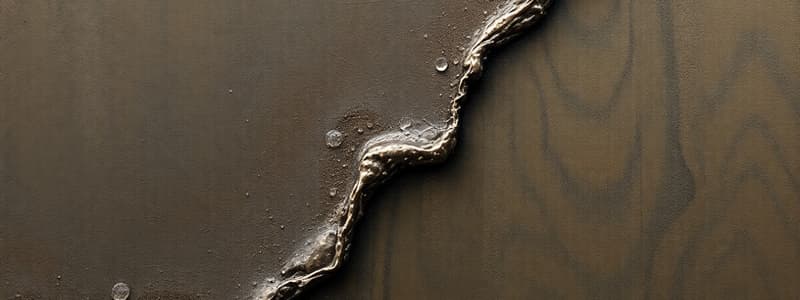Podcast
Questions and Answers
What is adhesion?
What is adhesion?
Adhesion is a complex physicochemical process occurring at the interface of two (solid) materials brought into an intimate contact, which results in the formation of an attractive force between the two materials.
What does adhesion depend on?
What does adhesion depend on?
Adhesion depends upon an adhesive making intimate physical contact with the substrate (wetting the surface). Covalent or ionic chemical bonds are not necessary.
What does an adhesive do?
What does an adhesive do?
An adhesive holds two substances together (adherend) without failure of the bond.
What is the most important property of an adhesive?
What is the most important property of an adhesive?
What are the different types of adhesion?
What are the different types of adhesion?
How does the thickness of the adhesive layer affect adhesion?
How does the thickness of the adhesive layer affect adhesion?
Describe mechanical adhesion.
Describe mechanical adhesion.
Describe diffusive adhesion.
Describe diffusive adhesion.
What are the ideal properties of an adhesive?
What are the ideal properties of an adhesive?
Is the adhesive layer uniform?
Is the adhesive layer uniform?
What is believed to control the durability and strength of an adhesive joint?
What is believed to control the durability and strength of an adhesive joint?
What else is the boundary layer composition also mainly responsible for?
What else is the boundary layer composition also mainly responsible for?
What is the boundary layer composition frequently a site of?
What is the boundary layer composition frequently a site of?
What are the different modes of failure with adhesion?
What are the different modes of failure with adhesion?
Why do we only use shear and tensile tests in dentistry to test adhesion?
Why do we only use shear and tensile tests in dentistry to test adhesion?
What does enamel etching lead to and why is it necessary?
What does enamel etching lead to and why is it necessary?
What actually happens in enamel etching?
What actually happens in enamel etching?
What is the standard etchant used and what are the results?
What is the standard etchant used and what are the results?
How long should you etch for and what does this remove?
How long should you etch for and what does this remove?
What is the path of local fracture usually like and how does this affect bond strength?
What is the path of local fracture usually like and how does this affect bond strength?
What are the 2 types of bonding agents?
What are the 2 types of bonding agents?
Why are sealants used?
Why are sealants used?
What are the types of sealants?
What are the types of sealants?
What type of etching do sealants use?
What type of etching do sealants use?
What are the chemical properties of dentine compared to composites?
What are the chemical properties of dentine compared to composites?
What may a dentine bonding agent consist of?
What may a dentine bonding agent consist of?
How can adhesive monomers be used to enhance dentine bonding?
How can adhesive monomers be used to enhance dentine bonding?
What does 4-META monomer do?
What does 4-META monomer do?
What is a key component in many dentine and metal primers?
What is a key component in many dentine and metal primers?
How much of an adhesive monomer needs to be present for it to be effective?
How much of an adhesive monomer needs to be present for it to be effective?
What creates a smear layer?
What creates a smear layer?
Where are the dentinal tubules strongest?
Where are the dentinal tubules strongest?
What gives rise to a hybrid layer?
What gives rise to a hybrid layer?
The adhesive layer is uniform.
The adhesive layer is uniform.
Which of the following are types of adhesion?
Which of the following are types of adhesion?
Which of the following are modes of failure with adhesion?
Which of the following are modes of failure with adhesion?
Which of the following are types of sealants?
Which of the following are types of sealants?
Flashcards
What is adhesion?
What is adhesion?
Adhesion is a complex physicochemical process at the interface of two materials, creating an attractive force between them when brought into intimate contact.
What does adhesion depend on?
What does adhesion depend on?
Adhesion depends on an adhesive making intimate physical contact with the substrate to wet the surface.
What does an adhesive do?
What does an adhesive do?
An adhesive holds two substances (adherends) together without failure of the bond.
Most important adhesive property?
Most important adhesive property?
Signup and view all the flashcards
Types of adhesion?
Types of adhesion?
Signup and view all the flashcards
Thickness of adhesive layer?
Thickness of adhesive layer?
Signup and view all the flashcards
Mechanical adhesion
Mechanical adhesion
Signup and view all the flashcards
Chemical adhesion
Chemical adhesion
Signup and view all the flashcards
Diffusive adhesion
Diffusive adhesion
Signup and view all the flashcards
Ideal adhesive properties?
Ideal adhesive properties?
Signup and view all the flashcards
Is the adhesive layer uniform?
Is the adhesive layer uniform?
Signup and view all the flashcards
Controls durability and strength?
Controls durability and strength?
Signup and view all the flashcards
Responsible for transfer of stress?
Responsible for transfer of stress?
Signup and view all the flashcards
Frequent site of?
Frequent site of?
Signup and view all the flashcards
Modes of failure?
Modes of failure?
Signup and view all the flashcards
Adhesion tests in dentistry?
Adhesion tests in dentistry?
Signup and view all the flashcards
Enamel etching?
Enamel etching?
Signup and view all the flashcards
What happens in enamel etching?
What happens in enamel etching?
Signup and view all the flashcards
Standard etchant and results?
Standard etchant and results?
Signup and view all the flashcards
Etching duration & removal?
Etching duration & removal?
Signup and view all the flashcards
Path of local fracture?
Path of local fracture?
Signup and view all the flashcards
Types of bonding agents?
Types of bonding agents?
Signup and view all the flashcards
Why are sealants used?
Why are sealants used?
Signup and view all the flashcards
Types of sealants?
Types of sealants?
Signup and view all the flashcards
Etching for sealants?
Etching for sealants?
Signup and view all the flashcards
Dentine vs. composites?
Dentine vs. composites?
Signup and view all the flashcards
what makes up a dentine bonding agent?
what makes up a dentine bonding agent?
Signup and view all the flashcards
What does 4-META monomer do?
What does 4-META monomer do?
Signup and view all the flashcards
Key component in primers?
Key component in primers?
Signup and view all the flashcards
Required amount of adhesive monomer?
Required amount of adhesive monomer?
Signup and view all the flashcards
What creates a smear layer?
What creates a smear layer?
Signup and view all the flashcards
Strength of dentinal tubules?
Strength of dentinal tubules?
Signup and view all the flashcards
What gives rise to a hybrid layer?
What gives rise to a hybrid layer?
Signup and view all the flashcards
Study Notes
- Adhesion involves a physicochemical process at the point of contact between two materials, creating an attractive force.
- Adhesion relies on the adhesive physically contacting the substrate by wetting the surface.
- Covalent or ionic chemical bonds are not essential for adhesion.
- An effective adhesive joins two substances (adherends) without bond failure.
- The most crucial adhesive property is its ability to make close contact with a surface for strong bonding.
Types of Adhesion
-
Chemical
-
Mechanical
-
Electrostatic
-
Diffusive
-
Dispersive
-
A thin adhesive layer is preferable for uniformly distributing stresses and loads applied to the substrate.
Mechanical Adhesion
- Rough or porous surfaces enhance adhesion due to a larger interfacial area.
- Micromechanical retention of the adhesive occurs within surface micro-voids.
- An example of mechanical adhesion is acid etching of enamel.
Chemical Adhesion
- Adhesive molecules are able to form chemical bonds (ionic or covalent) with the adherend's molecules.
- Free radical reaction of vinyl groups shows chemical adhesion.
Diffusive Adhesion
- Molecules move across the interface for adhesion if the adhesive and adherend molecules are similar.
- Composite repairs and dentine bonding agents are examples of diffusive adhesion.
Ideal Properties of Adhesives
-
Should wet the adherend surface with a low contact angle and appropriate surface energy.
-
The adhesive's surface energy must be lower than the substrate's for proper wetting
-
Should flow easily over the substrate with low initial viscosity.
-
Ability to displace air from the interface minimizes stress concentration and avoids inhibiting polymerization.
-
The physical and chemical properties of the adhesive can vary at non-contact points, while the core is typically homogenous.
-
The durability and strength of an adhesive joint is thought to be controlled by the boundary layer composition.
-
The boundary layer composition is responsible for stress transfer between adherends.
-
The boundary layer composition is frequently a site of environmental attack and subsequent failure.
Modes of Failure in Adhesion
-
Structural failure: Failure within the material
-
Adhesive failure: Failure at the adhesive interface
-
Cohesive failure: Failure within the adhesive itself
-
Shear and tensile tests are used in dentistry to test adhesion due to tooth structure substrate limitations.
-
Enamel etching creates an irregular surface, enabling micromechanical retention as the adhesive penetrates.
-
Acid etching of enamel selectively dissolves hydroxyapatite, allowing adhesive penetration and forming resin tags.
-
Standard etchant: 30-50% phosphoric acid greatly increases surface area, with etched enamel patterns classified as:
- Type 1: Preferential dissolution of the prism core
- Type 2: Preferential dissolution of the periphery of the prisms
- Type 3: a mix of Type 1 & 2
-
Etching time:
- 15 seconds on cut enamel
- 30-60 seconds on uncut enamel
-
Etching removes approximately 5 microns of the surface, including:
- Adsorbed pellicle
- Amorphous CaP layer
- Smear layer (if present on cut surfaces)
-
Local fracture usually goes through the interrod and parallel to the rod head.
-
Fracture parallel to rods results in a 40% reduction in bond strength
Types of Bonding Agents
-
One type involves phosphoric acid etching and rinsing before applying acidic monomers and resin in solvent.
-
The other type (self-etch) uses an acidic monomer primer to dissolve the surface HA, followed by resin application in solvent.
-
Sealants: A cost-effective caries preventive measure.
Types of Sealants
-
Filled, unfilled
-
Self-cured
-
Light cured
-
There is no difference in efficacy with type
-
Sealants typically use phosphoric acid etching and self-etching, which is less effective in clinical studies.
-
Dentine is hydrophilic, composites are hydrophobic.
-
Dentine is vital, with organic and inorganic components, and is covered by a smear layer.
Dentine Bonding Agent Components
-
Etchant, primer, and sealant/bonding agent OR
-
Weak or strong self-etching primer combined with a bond
-
Adhesive monomers enhance dentine bonding
4-META Monomer
-
Reacts in the presence of moisture to form two carboxyl groups
-
Responsible for adhesion
-
Requires a special catalyst for polymerization
-
Bonds to metal (base) and enamel/dentine
-
MDP is a key component in many dentine and metal primers
-
Adhesive monomers are effective at concentrations between 2-10% by weight of total monomers.
-
Smear layer creation: Any mechanical manipulation of dentine creates a smear layer and is acid labile, and can be easily washed off with acid.
-
Dentinal Tubules near EDJ have higher bond strengths and tubules near the pulp have lower bond strengths.
-
The ability of primers and resins to infiltrate demineralized dentine leads to the formation of a hybrid layer at the dentine-resin interface.
Studying That Suits You
Use AI to generate personalized quizzes and flashcards to suit your learning preferences.




